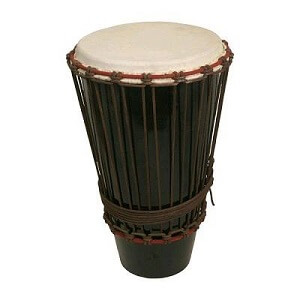Aburukuwa
 The akukuadwo is a single-head membranophone of the Akan peoples of southern Ghana. It is a support drum used in the kete ensemble of the Akan peoples. The kete ensemble, and therefore the akukuadwo, is associated with traditional chiefs. Only one akukuadwo is needed in the kete ensemble, but some sets may include more than one. Like almost all drumming in Akan society, the playing of the akukuadwo is restricted to males. Red and black are colors that the Akan associate with death and funerals, and one important context for which the kete ensemble is used is funerals of chiefs, which explains the cloth checkerboard pattern adorning the drum’s shell.
The akukuadwo is a single-head membranophone of the Akan peoples of southern Ghana. It is a support drum used in the kete ensemble of the Akan peoples. The kete ensemble, and therefore the akukuadwo, is associated with traditional chiefs. Only one akukuadwo is needed in the kete ensemble, but some sets may include more than one. Like almost all drumming in Akan society, the playing of the akukuadwo is restricted to males. Red and black are colors that the Akan associate with death and funerals, and one important context for which the kete ensemble is used is funerals of chiefs, which explains the cloth checkerboard pattern adorning the drum’s shell.
The partly conical, partly cylindrical-shaped shell of the akukuadwo is carved from a single block of wood, preferably a local variety of cedar called tweneboa. The shape of the shell’s cavity mirrors that of its exterior. Although the shell of this drum is tubular, its bottom end is closed off with a thin board of wood with a soundhole in its center (see detail photo); it is therefore very close to being considered a vessel drum. Five holes are drilled at an angle through the shell and spaced equidistantly around its circumference about a third of the way down from the top opening of the shell. Into each of these holes is inserted a peg, ideally made from ofema wood. The exposed ends of the pegs are notched near their end to produce a cap around which the wire loops of the drumhead will be secured. The drumhead is made of a circle of antelope rawhide that is folded over and between two plant-fiber hoops of a diameter slightly larger than that of the opening of the drum shell. A very long length of wire is then threaded through holes (15 in all) on the bottom side of the hide and around one of the hoops in such a way as to produce seven sets of loops for attachment to the drum’s tuning pegs. The remaining edge of the antelope hide is then folded over the top of the second hoop and trimmed. The straight drumsticks used to beat the drum are made from ofema tree branches. Squares of black and red cloth are sewn together and then attached to the exterior of the drum shell with nails and tacks.